Investigation of Wire Coating Using Hydromagnetic Third-Grade Liquid for Coating along with Hall Current and Porous Medium
Abstract
In this research study, we investigated and performed coating analysis of wire by using MHD convective third-order fluid in the presence of a permeable matrix taking into account the Hall current. The equations that control the motion of fluid in the chamber are first modeled and then numerically solved by using 4th order Runge–Kutta–Fehlberg technique. The Runge–Kutta–Fehlberg method is a powerful tool used in this article to attain a numerical solution for a system of nonlinear ordinary differential equations describing the problem of fluid flow. The impact of governing parameters on velocity and temperature profiles is investigated graphically. It is noticed that the velocity profiles u(r) rise as the value of viscoelastic parameter β increases and slow down when the permeability parameter K and the Hartmann number M increase. Also, the temperature profiles θ(r) enhance as the Brinkman number Br, permeability parameter K, magnetic parameter M, and non-Newtonian parameter β increase. For the sake of validation, the proposed method is also compared with BVPh2, and good agreement is found. Furthermore, a comparison is also done with the published work as a limiting case.
1. Introduction
Coating process is the major insulation of polymers with molten polymers for mechanical strength and to safeguard against the aggressive surroundings. Nylon, polysulfide, low-/high-density polyethylene (LDPE/HDPE), and plastic polyvinyl chloride (PVC) are common and important plastic resins used for wire coatings. The metallic coating technique is an engineering process use for the supply of insulation, environmental safety, mechanical damage and protect against signal attenuation. An appropriate and easy way of wire coating is the coaxial extrusion procedure that work at maximum pressure, temperature, and wire drawing velocity [1–4]. Pressure-type die has a very closed resemblance with an annulus, and accordingly, flow through this sort of die has a likeness with the flow through the annular region formed by the two coaxial cylinders, out of which the internal cylinder is moving in the axial direction, while the external cylinder is considered fixed. Distinct types of fluids are considered for wire, which depends upon the geometry of die, fluid viscosity, the temperature of the wire, and that of the molten polymer. A substantial care has been assumed to the Newtonian fluids to investigate the result of heat transfer analysis in the process of wire coating. Numerous fluids such as air, water, and other lubricants are considered as non-Newtonian fluids in science and engineering technologies. In many situations, the idea of the Newtonian fluid behavior is not so trivial, and it may be more complicated, and a perturbed (non-Newtonian) model must be considered. The non-Newtonian behavior exists in different liquid materials such as glue, paint, ketchup, custard, and blood. Because of its vast and significant uses in industry, petroleum and chemical engineering, and in other fluid mechanics, it obtained the attention of researchers [5–10].
Ellahi et al. [11] discussed the non-Newtonian micropolar liquid in the blood movement over composite stenosis. Eyring–Powell fluid is a non-Newtonian fluid, which was first presented in 1944 by Eyring–Powell. Many important features of Eyring–Powell fluid are discussed by researchers [12–16]. Wire coating technique is very important as it avoids injuries and decreases the losses that could be generated by machine oscillation. In manufacturing industries, various liquefy polymers are used in wire coating process. A melt polymer is put on over a wire, and then, the wire is dragged over the die covered by a viscoelastic material. Three methods used for wire coating are termed as electrostatistical deposition, dripping, and coaxial process. As compared to the remaining two, the dipping method in wire coating technique provides stronger links in the field, but it is very slow. It contains a payoff device, die, extruder device, cooling device, preheater, straightener, tester, capstan, and take-up roll. In the process, a bare wire is set rolling over the payoff device, which goes through straighter after which heat is provided to the wire by a preheater and cross-head die, which has a canonical die accumulating the liquefy polymer, and the wire is coated. The temperature of hot-coated wire is reduced with a cooling device after which it goes through a capstan, then a tester, and finally, the coated wire is puffing at take-up reel. Many other researchers [17–23] use various non-Newtonian materials for the wire coating process. In magnetohydrodynamic (MHD), the magnetic field induces the current, which have a major effect on the motion of the fluid material. In recent years, MHD has been an attractive area for researcher because of its vast usage in different industrial process just as magnetic material and glass manufacture processing. Many researchers [24–29] considered MHD as a current conducting liquid in the presence/absence of magnetic field and its consequences.
Fluid flux through a permeable medium has a countless significance for scientists because of its broad scope in engineering technology. Some of renowned permeable media are wood, carbonate rocks, and metal foams. Many researchers [30–34] paid attention to permeable media. Currently, a thin permeable layer is used in different domestic and industrial applications such as filters, batteries, fuel cell, and printing papers. The study of the heat convection in the non-Newtonian liquids got interest with time because of its usage in different industries. Rehman and Nadeem [35] investigated heat convective analysis for multidirectional stagnation flow movement. Khan along with other researchers [36–41] studied the effect of thermal convection and MHD fluid flow. By studying all the above studies, it is found that wire coating technique with MHD of a viscoelastic Eyring–Powell liquid as coating substance has yet not been discussed. In this paper, a procedure of the wire coating process with impact of thermal generation and a permeable medium along with temperature dependent flexible viscosity using Vogel’s and Reynolds is discussed.
In this study, we consider the influence of MHD and heat transfer on the steady flow of a viscoelastic fluid, in which the wire is drawn at a higher speed in the presence of a porous medium and taking into account the Hall current. Although there are several studies of the flow and heat transfer of non-Newtonian fluids, a careful study of the literature shows that very little attention is paid to a viscoelastic fluid. As far as we know, no one has studied the MHD flow and heat transfer of a viscoelastic fluid to analyze wire coating in the presence of a porous medium. In this context, the governing equations for the velocity and temperature profiles are solved by the 4th order Runge–Kutta method.
2. Mathematical Analysis
In coating process, the wire is extruded in a central line of the die of the coating chamber along with speed V having fluid temperature θW and radius of the wire being RW. The bath of third-grade fluid utilized as a melt polymer, such as polyvinyl chloride (PVC), for coating purposes in the presence of porous media inside the static pressure driven type die of length L, radius Rd, and the temperature θd is shown in Figure 1. The liquid performs on a constant axial pressure gradient, and magnetic field of strength B0 applies in transverse. Magnetic field is applied perpendicular to the flow direction to an incompressible fluid. Reynolds number is taken small enough as possible so that the induced magnetic field can be ignored. The Lorentz force can affect this installation, and as a result, the coating process gets affected from it.
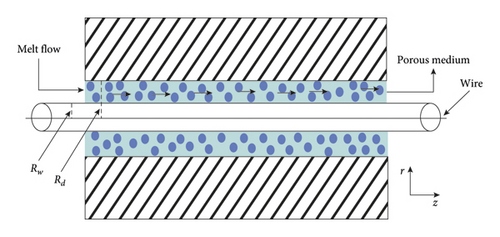
2.1. Governing Equations
3. Numerical Solution Procedure
4. Validation of the Proposed Method
To test our numerical solution, we make the following comparison, which confirms the carefulness of the proposed method. Our comparison is shown in Tables 1 and 2 for velocity and temperature profiles, respectively. Excellent agreement was noted between our data and previous published work by [21]. For more accuracy, the graphical comparison of the Runge–Kutta method and BVPh2 are also given in Figures 2 and 3, respectively.
| u(r) | Runge–Kutta method | BVPh2 | Published work [21] |
|---|---|---|---|
| 1.0 | 1.00000000000 | 1.00000000000 | 1.00000000000 |
| 1.4 | 0.69133128205 | 0.69133128206 | 0.69133128211 |
| 1.8 | 0.44146461538 | 0.44146461531 | 0.44146461531 |
| 2.2 | 0.24891076923 | 0.24891076926 | 0.24891076918 |
| 2.6 | 0.10622358974 | 0.10622358965 | 0.10622358960 |
| 3.0 | 0.00000000000 | 0.00000000000 | 0.00000000000 |
| θ(r) | Runge–Kutta method | BVPh2 | Published work [21] |
|---|---|---|---|
| 1.0 | 0.00000000000 | 0.00000000000 | 0.00000000000 |
| 1.4 | 0.3076294200 | 0.3076294214 | 0.3076294210 |
| 1.8 | 0.5609506277 | 0.5609506256 | 0.5609506267 |
| 2.2 | 0.7595871849 | 0.7595871853 | 0.7595871786 |
| 2.6 | 0.9047988740 | 0.9047988743 | 0.9047988745 |
| 3.0 | 1.00000000000 | 1.00000000000 | 1.00000000000 |
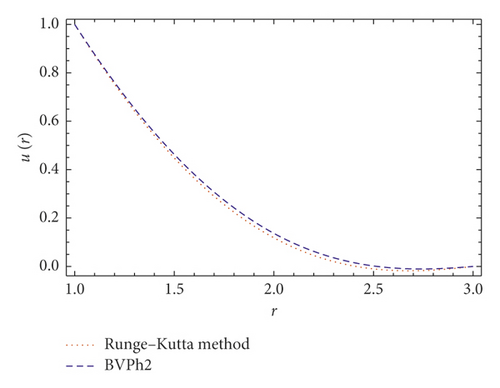
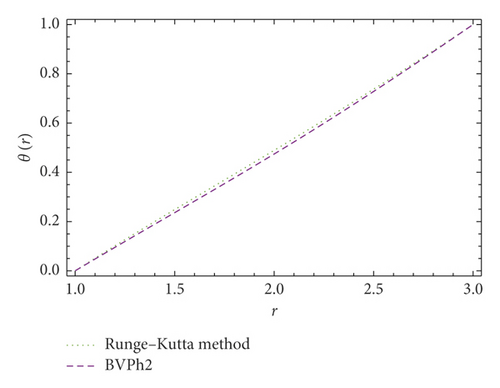
5. Discussion
In this section, a brief study has been presented relevant to the emerging parameters which arises in the problem graphically and are discussed in Figures 4-11–12.
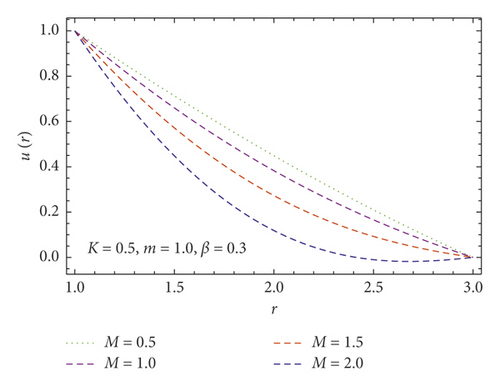
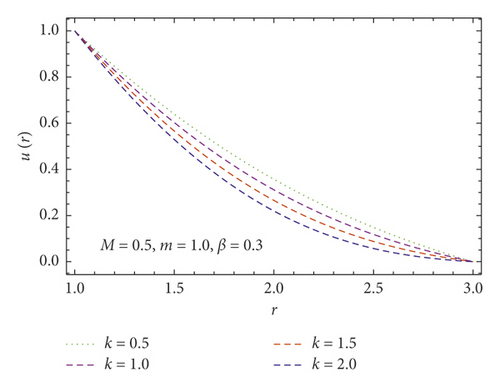
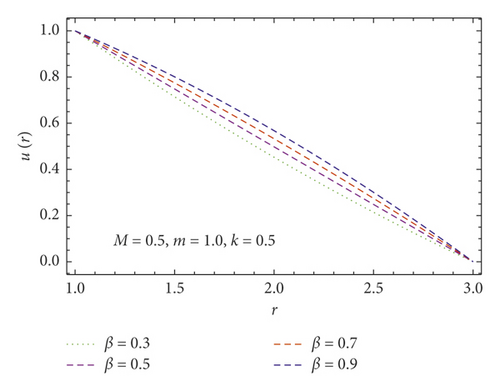
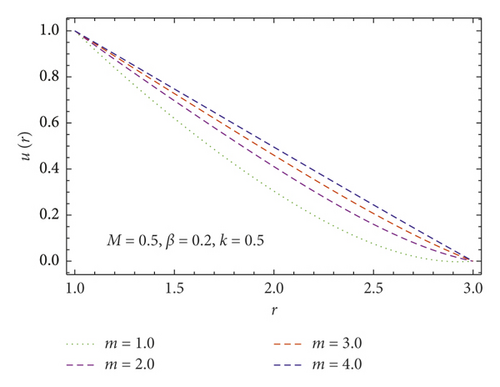
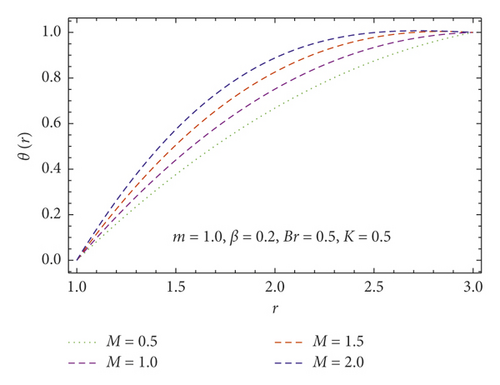
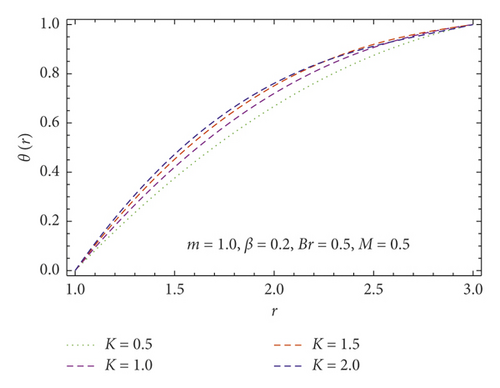
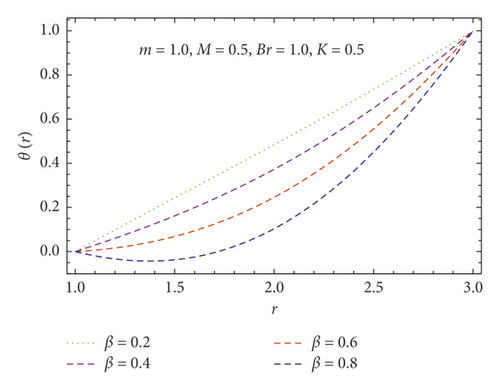
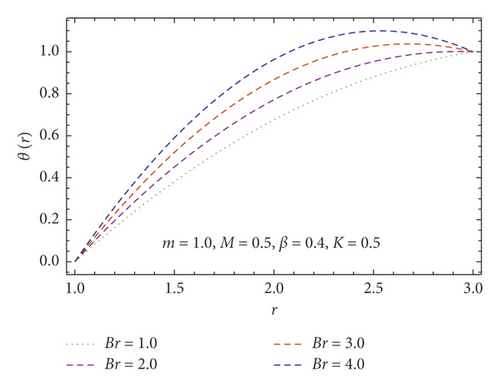
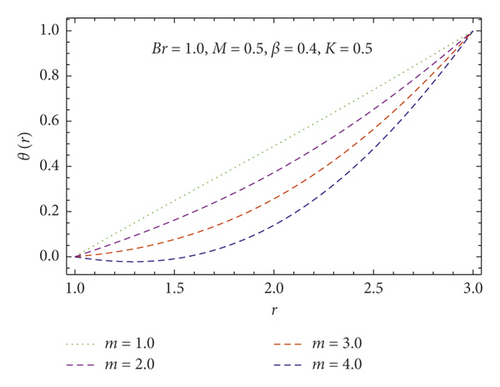
Figure 4 is sketched to examine the influence of magnetic parameter M on the velocity profile u(r). A clear decline in the velocity profile has been observed in the complete flow domain for greater values of magnetic parameter pointed out. This is due to the application of the magnetic field effect on an electrically conducting liquid which gives rise to opposing force recognized as the Lorentz force. This resistive force has propensity to slow down the motion of the fluid in the boundary layer section. Figure 5 depicts that as the magnitude of porosity parameter increases, as a result, the velocity profile decreases significantly. Figures 6 and 7 are designed to see the impact of the incompressible viscoelastic third-grade parameter β and Hall current parameter m on the velocity profile. It is noticed that both viscoelastic third-grade fluid parameter β and Hall current parameter m enhance the fluid velocity at all points in the presence/absence of magnetic field. We investigated the impact of the magnetic parameter M upon the temperature profile θ(r)(Figure 8). It is clear that the temperature profile grows up in the entire flow region of the fluid flow with increasing applied magnetic field M. This may be attributed to the boundary surface affects which override the effect of magnetic field.
The influence of porous parameter K on the temperature profile θ(r) is shown in Figure 9. It revealed that the higher values of the porosity parameter K heat up the fluid temperature uniformly in the flow region. In Figure 10, the impact of non-Newtonian parameter β on the temperature has been analyzed. It is pointed out that a clear decline in the temperature of the fluid for higher values of the non-Newtonian parameter β is observed. It is observed that the non-Newtonian parameter decreases the temperature both in the presence/absence of magnetic field. Figure 11 indicates that temperature distribution increases with an increase in the Brinkman number Br. It is seen that as the Brinkman number increases, the temperature profile increases significantly at all points. Hence, it is observed that in the process of wire coating, the Brinkman number is the relative measure of viscous heating with conducted heat, and the temperature significantly accelerates uniformly at all points. Figure 12 shows that the Hall parameter decreases the temperature profiles in the presence of porous matrix.
6. Conclusions
- (i)
The velocity profile increases with the increasing value of viscoelastic third-grade parameter
- (ii)
It is noticed that the velocity profiles grow up at high rate as the Hall parameter increases
- (iii)
The fluid temperature decreases with the rising values of the magnetic parameter, viscoelastic third-grade parameter, Hall parameter, and permeability parameter and increases with the Brinkman number
Conflicts of Interest
The authors declare that they have no conflicts of interest.
Acknowledgments
The authors are thankful to King Khalid University of Saudi Arabia for financial support to this research under the grant number R.G.P.2/7/38.
Open Research
Data Availability
The data used to support the findings of this study are available from the corresponding author upon request.




